
The Silver Star Medal (SSM) is the United States Armed Forces' third-highest military decoration for valor in combat. The Silver Star Medal is awarded primarily to members of the United States Armed Forces for gallantry in action against an enemy of the United States.

The Distinguished Flying Cross (DFC) is the third-level military decoration awarded to officers, and since 1993 to other ranks, of the United Kingdom's Royal Air Force and other services, and formerly to officers of other Commonwealth countries, for "an act or acts of valour, courage or devotion to duty whilst flying in active operations against the enemy".

The Distinguished Service Order (DSO) is a military decoration of the United Kingdom, as well as formerly of other parts of the Commonwealth, awarded for operational gallantry for highly successful command and leadership during active operations, typically in actual combat. Since 1993 it has been awarded specifically for "highly successful command and leadership during active operations", with all ranks being eligible.

The Military Cross (MC) is the third-level military decoration awarded to officers and other ranks of the British Armed Forces, and formerly awarded to officers of other Commonwealth countries.
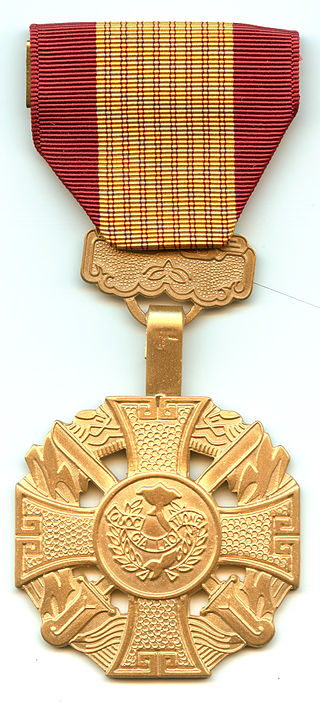
The Republic of Vietnam Gallantry Cross also known as the Vietnamese Gallantry Cross or Vietnam Cross of Gallantry is a military decoration of the former Government of South Vietnam. The medal was created on August 15, 1950, and was awarded to military personnel, civilians, and Armed Forces units and organizations in recognition of deeds of valor or heroic conduct while in combat with the enemy.
To be mentioned in dispatches describes a member of the armed forces whose name appears in an official report written by a superior officer and sent to the high command, in which their gallant or meritorious action in the face of the enemy is described.

The Military Medal (MM) was a military decoration awarded to personnel of the British Army and other arms of the armed forces, and to personnel of other Commonwealth countries, below commissioned rank, for bravery in battle on land. The award was established in 1916, with retrospective application to 1914, and was awarded to other ranks for "acts of gallantry and devotion to duty under fire". The award was discontinued in 1993, when it was replaced by the Military Cross, which was extended to all ranks, while other Commonwealth nations instituted their own award systems in the post war period.

The Conspicuous Gallantry Medal (CGM) was, until 1993, a British military decoration for gallantry in action for petty officers and seamen of the Royal Navy, including Warrant Officers and other ranks of the Royal Marines. It was formerly awarded to personnel of other Commonwealth countries. In 1943 a Royal Air Force version was created for conspicuous gallantry in action against the enemy in the air.
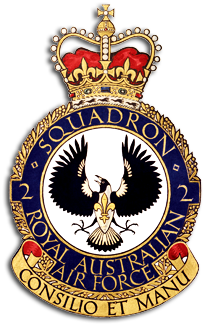
No. 2 Squadron is a Royal Australian Air Force (RAAF) squadron that operates from RAAF Base Williamtown, near Newcastle, New South Wales. From its formation in 1916 as part of the Australian Flying Corps, it has flown a variety of aircraft types including fighters, bombers, and Airborne Early Warning & Control (AEW&C). During World War I, the squadron operated on the Western Front conducting fighter sweeps and ground-attack missions. It was disbanded in mid-1919, following the end of hostilities. The squadron was briefly re-raised in 1922 as part of the newly independent RAAF, but was disbanded after only a couple of months and not reformed until 1937. It saw action as a bomber unit in the South West Pacific theatre of World War II and, equipped with English Electric Canberra jets, in the Malayan Emergency and the Vietnam War. The squadron was again disbanded in 1982, following the retirement of the Canberra. It was re-formed in 2000 to operate the Boeing 737 AEW&C "Wedgetail". One of the six Boeing 737s was deployed to the Middle East in September 2014, as part of Australia's contribution to the military coalition against ISIS.

The King's Gallantry Medal (KGM), formerly the Queen's Gallantry Medal (QGM), is a United Kingdom decoration awarded for exemplary acts of bravery where the services were not so outstanding as to merit the George Medal, but above the level required for the King's Commendation for Bravery.
The Star of Gallantry (SG) is a military decoration awarded to personnel of the Australian Defence Force (ADF) and other persons recognised by the Minister for Defence. It is awarded for acts of great heroism or conspicuous gallantry in action in circumstances of great peril. It is the second highest of the military gallantry awards in the Australian Honours System, only surpassed by the Victoria Cross or Victoria Cross for Australia (VC).

No. 466 Squadron RAAF was a Royal Australian Air Force (RAAF) bomber squadron during World War II. Formed in the United Kingdom in late 1942, the squadron undertook combat operations in Europe until the end of the war, flying heavy bomber aircraft. Following the conclusion of hostilities with Germany, the squadron began retraining to undertake operations in the Pacific against the Japanese, but the war came to an end before it left the UK. In late 1945, the squadron was disbanded.
The Unit Citation for Gallantry is a collective group decoration awarded to members of Australian military units. It recognises extraordinary gallantry in action. The Unit Citation for Gallantry was created in 1991, along with the Meritorious Unit Citation. The actual citation is a warrant presented to the unit. Insignia are worn by individuals to denote their membership of a unit that has been awarded a citation. Personnel cannot be issued with the insignia until the authorised unit representative, normally the Commanding Officer, has been formally invested with the citation.

The Experimental Military Unit (EMU) was a joint Australian-American company-sized helicopter assault force which operated during the Vietnam War. The unit was created in 1967 following a request from the United States military for Australia to send more helicopter pilots to the conflict. As the only available personnel were from the Royal Australian Navy (RAN) Fleet Air Arm, the RAN Helicopter Flight Vietnam (RANHFV) was formed and integrated into the 135th Assault Helicopter Company of the United States Army. The EMU unit name was selected by the Americans as a backronym for the Australian bird, a choice which amused the Australians: despite being large, fast, and highly mobile, the emu cannot fly.
Air Commodore Raymond James Brownell, was a senior officer in the Royal Australian Air Force (RAAF) and a First World War flying ace. Born in Hobart, Tasmania, Brownell was working as a clerk with a firm of accountants when he enlisted in the Australian Imperial Force on the outbreak of the First World War. He served during the Gallipoli Campaign before transferring to the Western Front. Awarded the Military Medal for his actions during the Battle of Pozières, he was accepted for a transfer to the Royal Flying Corps in 1917. After flight training in the United Kingdom, Brownell was commissioned as a second lieutenant and posted for operational service over the Western Front in September 1917. Moving with his squadron to Italy, he was awarded the Military Cross and credited with shooting down 12 aircraft by war's end. Taking his discharge in 1919, Brownell returned to Australia.
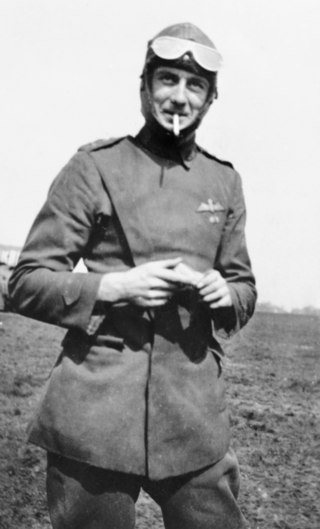
Air Vice Marshal Adrian Lindley Trevor Cole, CBE, DSO, MC, DFC was a senior commander in the Royal Australian Air Force (RAAF). Joining the army at the outbreak of World War I, he transferred to the Australian Flying Corps in 1916 and flew with No. 1 Squadron in the Middle East and No. 2 Squadron on the Western Front. He became an ace, credited with victories over ten enemy aircraft, and earned the Military Cross and the Distinguished Flying Cross. In 1921, he was a founding member of the RAAF.
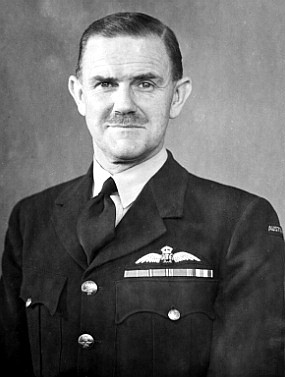
Air Vice-Marshal Francis Masson Bladin, was a senior commander in the Royal Australian Air Force (RAAF). Born in rural Victoria, he graduated from the Royal Military College, Duntroon, in 1920. Bladin transferred from the Army to the Air Force in 1923, and learned to fly at RAAF Point Cook, Victoria. He held training appointments before taking command of No. 1 Squadron in 1934. Quiet but authoritative, he was nicknamed "Dad" in tribute to the concern he displayed for the welfare of his personnel.
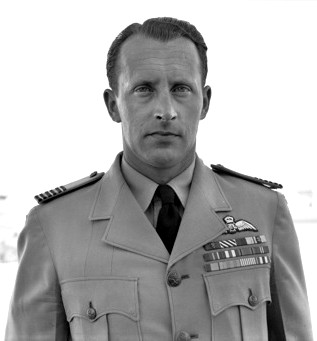
Air Vice-Marshal Brian Alexander Eaton, was a senior commander in the Royal Australian Air Force (RAAF). Born in Tasmania and raised in Victoria, he joined the RAAF in 1936 and was promoted to flight lieutenant on the outbreak of World War II. He held training positions before being posted to No. 3 Squadron at the beginning of 1943, flying P-40 Kittyhawk fighter-bombers in North Africa. Despite being shot down three times within ten days soon after arriving, Eaton quickly rose to become the unit's commanding officer, and by year's end had been awarded the Distinguished Flying Cross. His leadership earned him the Distinguished Service Order and Bar in 1944–45, and command of No. 239 Wing RAF in Italy, with the temporary rank of group captain. He was also awarded the US Silver Star in 1946 in recognition of his war service.

Vance Drummond, was a New Zealand–born Australian pilot who fought in the Korean and Vietnam Wars. He initially saw service in the New Zealand military, but joined the Royal Australian Air Force in 1949 and graduated as a sergeant pilot in 1951. Posted to No. 77 Squadron in Korea, he flew Gloster Meteor jet fighters and earned the US Air Medal for his combat skills. He was shot down by a Mikoyan-Gurevich MiG-15 in December 1951 and imprisoned for almost two years. After returning to Australia he converted to CAC Sabre jets and in December 1961 became a flight commander with No. 75 Squadron; he subsequently led the squadron's Black Diamonds aerobatic team, and was awarded the Air Force Cross in 1965.

Garry Gordon Cooper, is a retired airline captain and a former fighter pilot in the Royal Australian Air Force (RAAF) who attained the rank of flight lieutenant. Cooper served on assignment with the United States Air Force (USAF) as a Forward Air Controller (FAC) in South Vietnam. Whilst working as a FAC in 1968, he was assigned to support the United States Army's 9th Infantry Division. For his actions in Vietnam, Cooper was awarded the Distinguished Flying Cross and the United States' Air Force Cross for heroism.